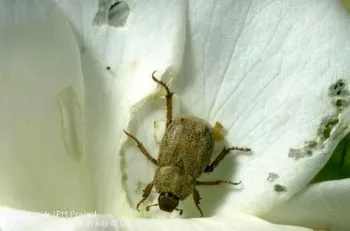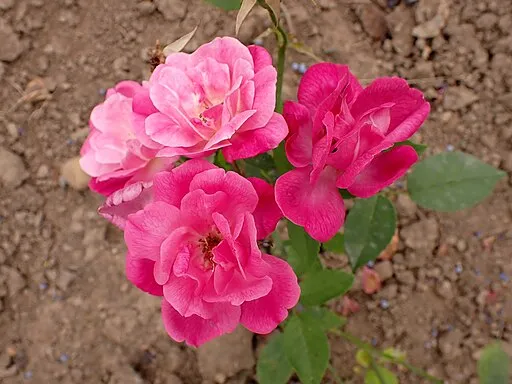Rosie's corner: Hoplia beetles make their annual appearance
by Debbie D

Did you know that the rose is the United States’ National flower? Well, apparently those flying beetles you may see on your roses this month do! Welcome to the annual invasion of the dreaded Hoplia beetle. Picture a small child stamping their feet and saying, “It’s so unfair!” You will have an image of me in my garden this time of year. We go through so much to get our beautiful first blooms – pruning, feeding, watering and watching our rose babies – only to have these beetles eat up all our new, beautiful, anticipated blooms! These insects love the Central Valley. They also love light colored rose flowers (dark red…not so much).
Most people confuse Hoplia beetles with Japanese beetles. They are not the same. Japanese beetles are an invasive species and have only been found in the Sacramento area of California. They tend to be in the eastern and Midwest portions of the U.S. Hoplia beetles are a golden brown color (see picture above), while Japanese beetles are metallic green with white spots on their margins. Japanese beetles are about the size of a penny. Hoplia beetles are smaller.
So, how do I get rid of these little buggers? Chemicals are not recommended. They are not effective. The best way is to use your thumb and index finger and squish them, as soon as you see them. Yes, there is a LARGE eeeuuuuwwwww factor! I wear very sturdy gloves when doing this. I also go out into my yard, at least twice a day (once in the morning and again late afternoon) to get them off my roses. BTW, they will attack your iris plants as well, so check iris flowers for them too.
Another way to get rid of them is to carry a bucket of soapy water with you and shake the rose flowers over the bucket. The beetles will supposedly fall into the bucket and drown. I have not found this effective for me in the past. I find that they tend to stick to the flower and the petals fall off instead. Those that managed to get into the bucket, did not drown. When I dumped the water, the beetles were crawling around on the ground. I then had to step on them for their demise. Another large eeeuuuwwww factor!
The good news about the Hoplia beetle is that their life cycle is about six weeks or so. They appear at the end of March and by the end of May, they are gone for another year. Whew!
Another pest I have seen on my roses this spring are aphids. They love breeding in the type of weather we have been having. A good strong blast of water from the hose, every couple of days, (make sure you get the underside of the leaves) is effective in killing them. One can also squish them. If your rose leaves look shiny or wet (before hitting them with a blast of water), that is probably the honeydew that is excreted from the aphid. So, check for aphids if you see this. You can spray for aphids, but the spray can be harmful to bees and beneficial insects, such as lady bird beetles (aka lady bugs). Aphids are their favorite food.
I grow lots of native California plants that lady bird beetles love. This way, I have a supply of lady bugs to eat the aphids as a biological control. I would encourage you to do the same instead of buying a container of them at the store. You know that old saying, “lady bug, lady bug, fly away home?” Without proper release of them from their container and plants that support lady bugs, that is exactly what they will do. Growing native California plants is also good for our native bees (they don’t sting you), butterflies and other pollinators. Many of our native plants are drought tolerant as well (another bonus!). They are also beautiful!

I do have the first rose blossom in my garden. The Alice Hamilton rose won the race. Who is Alice Hamilton? She was the first woman appointed to the faculty at Harvard University in 1919. According to Harvard University, she obtained her medical degree from the University of Michigan in 1893, studied at several universities in the U.S. and Europe, was professor of pathology at the Woman’s Medical College of Northwestern University and a bacteriologist at the Memorial Institute for Infectious Diseases in Chicago. In addition, she investigated industrial poisons for the Federal Department of Labor. She created the Department of Industrial Medicine at Harvard, which later became part of the Harvard School of Public Health. She made many contributions to medical practices, and they still apply today. Many of her research findings lead to the development of state and federal health and safety laws. However, because she was a female, she could not be let into the Faculty Club at Harvard, march in the academic processions at commencement, nor obtain faculty tickets to football games. Harvard also did not let her become tenured because she was a woman. So, my Alice Hamilton rose is very much the leader (in blooms) just as Alice was in real life. The rose named after her is a great rose for our central valley gardens.

Until next time . . . “You are the rose that makes my heart blossom.”—Unknown
